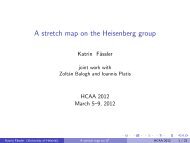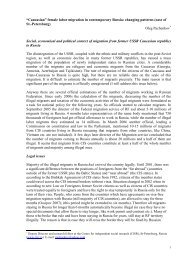Experiential metaphors in Latin - Wiley Online Library
Experiential metaphors in Latin - Wiley Online Library
Experiential metaphors in Latin - Wiley Online Library
You also want an ePaper? Increase the reach of your titles
YUMPU automatically turns print PDFs into web optimized ePapers that Google loves.
310<br />
The rema<strong>in</strong>der of this article is organised as follows. Section 3 provides an analysis of<br />
the metaphorical schema EXPERIENCES ARE THINGS POSSESSED, while section 4 is particularly<br />
concerned with <strong>in</strong>vestigat<strong>in</strong>g the STATES ARE CONTAINERS patterns. Section 5 looks at the<br />
EVENTS ARE MOVEMENTS metaphor. I close the paper with a summary of its ma<strong>in</strong> po<strong>in</strong>ts<br />
and conclusions, with a view to provid<strong>in</strong>g some <strong>in</strong>sights <strong>in</strong>to the fruitful relation<br />
between cognitive l<strong>in</strong>guistics, a corpus-based approach to <strong>metaphors</strong>, and classical<br />
philology (§6).<br />
3. THE POSSESSIVE CONSTRUCTION: A CASE OF DIACHRONIC GROWTH IN PRODUCTIVITY<br />
‘It is widely appreciated that the l<strong>in</strong>guistic category of possession does not reduce to any<br />
s<strong>in</strong>gle, familiar value, such as ownership. A moment’s thought reveals the extraord<strong>in</strong>ary<br />
variety of the relationships coded by possessive constructions’ (Langacker 1991: 169). This<br />
po<strong>in</strong>t is simple but worth stress<strong>in</strong>g: experienc<strong>in</strong>g someth<strong>in</strong>g can be conceived through the<br />
basic event schema of possess<strong>in</strong>g someth<strong>in</strong>g (Nikiforidou 1991: §3.2; Stolz et al. 2008:<br />
108). What we have is a situation of typological variation, <strong>in</strong> the sense that languages<br />
extend the possessive construction type <strong>in</strong>to neighbour<strong>in</strong>g semantic doma<strong>in</strong>s to vary<strong>in</strong>g<br />
degrees.<br />
However, possess<strong>in</strong>g an experience is someth<strong>in</strong>g different from possess<strong>in</strong>g, let us say, a<br />
bicycle. In prototypical possession, the possessor is by def<strong>in</strong>ition animate, the possessum is<br />
concrete and the possessor can use the possessum. In hav<strong>in</strong>g an experience, the only<br />
feature which is ma<strong>in</strong>ta<strong>in</strong>ed concerns the animacy of the possessor (i.e. the Experiencer),<br />
all other th<strong>in</strong>gs be<strong>in</strong>g altered (He<strong>in</strong>e 1997). Given the impalpable essence of experiential<br />
objects, l<strong>in</strong>guists have usually ma<strong>in</strong>ta<strong>in</strong>ed the general label of Abstract Possession to refer<br />
to this peculiar construction to <strong>in</strong>dicate that it lacks most of the semantic features that<br />
tend to show up <strong>in</strong> the case of prototypical possession (Ko¨ nig & Haspelmath 1998;<br />
Stassen 2009). The Abstract Possession construction <strong>in</strong>teracts transitively with the IDEAS<br />
ARE OBJECTS METAPHOR (Ko¨ vecses 2000: 89), where the m<strong>in</strong>d is conceptualized as someth<strong>in</strong>g<br />
that looks like a conta<strong>in</strong>er, while ideas, feel<strong>in</strong>gs and beliefs are conceived of as objects<br />
kept <strong>in</strong> it. As Seiler po<strong>in</strong>ts out, ‘after all, abstract nouns perta<strong>in</strong> to a l<strong>in</strong>guistic technique<br />
that allows actions and processes to be treated as if they were th<strong>in</strong>gs’ (Seiler 1983: 52), as<br />
<strong>in</strong> the follow<strong>in</strong>g examples from English:<br />
We share our ideas.<br />
I gave the idea to my mother.<br />
I have an idea.<br />
I took the idea from John.<br />
TRANSACTIONS OF THE PHILOLOGICAL SOCIETY 109, 2011<br />
As is well known, <strong>in</strong> Lat<strong>in</strong> two different strategies are used to encode possession: the Dative<br />
possession copular construction (e.g. liber mihi est ‘I have a book’, lit. ‘a book me.DAT is’)<br />
and the transitive construction with the verb habeo ‘I have’. In the former type, the Dativemarked<br />
possessor is ascribed a possessum: this is a very ancient option <strong>in</strong> Indo-European and<br />
displays several parallel structures <strong>in</strong> many other Indo-European languages (Ernout &<br />
Thomas 1972 [1951]: 73; Benveniste 1960: 223; on the two compet<strong>in</strong>g strategies <strong>in</strong> Lat<strong>in</strong>, see<br />
Magni 1999; Baldi & Nuti 2010: esp. §2). As we see below, the ‘have’-possessive construction<br />
started out as more concrete, preferably used to denote temporary possession, subsequently<br />
develop<strong>in</strong>g more abstract senses such as experienc<strong>in</strong>g physical feel<strong>in</strong>gs and emotions (cf. e.g.<br />
Lo¨ fstedt 1963; see also Baldi 2002).<br />
Lat<strong>in</strong> <strong>Experiential</strong> constructions featur<strong>in</strong>g either or both the possessive schemas are listed<br />
below:

















